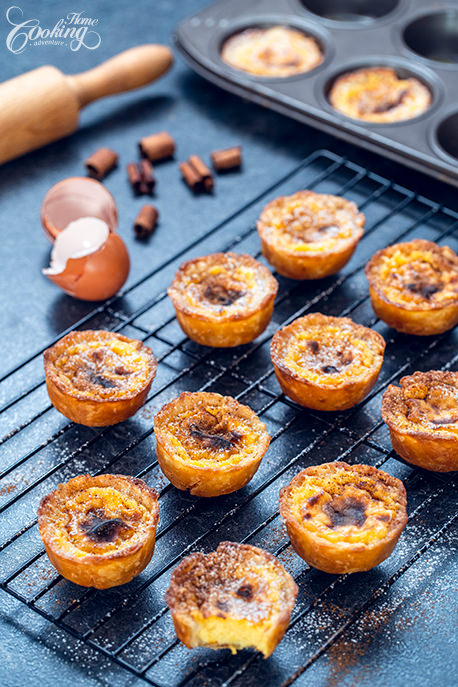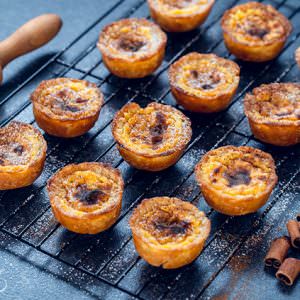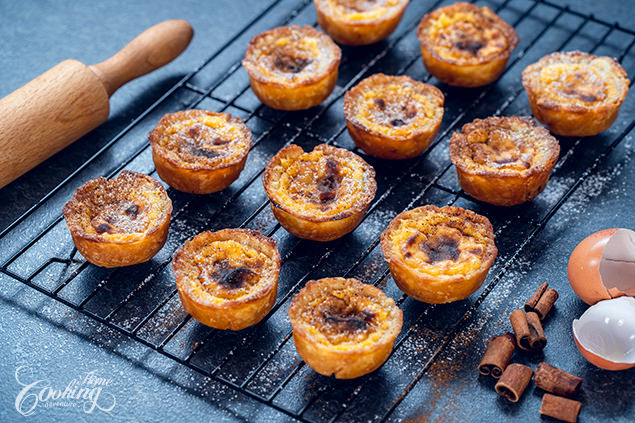Pastéis de Nata – Portuguese Custard Tarts are a popular Portuguese dessert, known and loved worldwide. It consists of a crispy flaky buttery crust filled with a smooth creamy custard filling, dusted with cinnamon and powdered sugar as a final touch. It is an incredible experience for your taste buds and you can hardly stop eating only one tart.
You can consider buying molds specific to these Portuguese Custard Tarts. But they can also be made simply using a muffin pan. Even if the results might not be as great and a bit smaller than the original ones, the tarts are still very satisfying and delicious.
How to make Pastéis de Nata – Portuguese Custard Tarts
The recipe is not very difficult and uses basic ingredients you already have in the house. It is best though, to make the pastry dough a day before so it has time to chill. If you don’t feel like making the pastry by yourself you can consider using store-bought puff pastry, though the result might not be the same.
When chilled, the dough is gently pressed onto the bottom and sides of the molds and then filled with the custard filling.
To prepare the custard filling first make a sugar syrup with water, sugar, lemon peel, and cinnamon sticks. Add it to a thickened mixture of flour, salt, milk, and vanilla extract. Add egg yolks and mix to combine. Strain the mixture and pour it into the pastry cups.
It takes about 10 minutes to bake at very high heat and soon results in this amazing symphony of colors, flavors, and texture.
The tars are best served warm, dusted with powdered sugar and cinnamon. Hope you will try these Pastéis de Nata. If you do, don’t forget to tag me on Instagram as I love seeing how it turns out for you. Enjoy!
Other custard desserts you may like to try
This Crème Brûlée is a classic French dessert that consists of a rich, creamy custard topped with a layer of caramelized sugar. It’s a popular dessert around the world and is often served with fresh berries or whipped cream.
Another custard dessert we love is for these Canelés de Bordeaux, small, cylindrical pastries that originated in the Bordeaux region of France. They have a caramelized exterior and a soft, custard-like interior, with flavors of vanilla or rum.
I highly recommend trying this Kremšnita – Vanilla Custard Cake, also known as Krempita, a classic European dessert. It consists of layers of puff pastry and vanilla custard that are perfect for special occasions and holidays.

YOU MAY ALSO LIKE:
Lemon Custard Rose Sweet Rolls
Norwegian Verdens Beste – World’s Best Cake
Eclair Cake

Pastéis de Nata - Portuguese Custard Tarts
Ingredients
Pastry Dough
- 1 cup (125g) all-purpose flour
- 1/4 tsp (1g) salt
- 3 fl. oz (90ml) water
- 1/2 cup (110g) unsalted butter , softened
For the custard
- 2/3 cup (135g) sugar
- 1/4 cup (50ml) water
- cinnamon sticks (8g)
- Peel from a small lemon
- 4 egg yolks
- 1/4 cup (30g) flour
- 1/4 tsp (1g) salt
- 1 cup (240ml) milk
- 1 tsp (5g) vanilla extract
For dusting
Instructions
Prepare the dough.
- Prepare the dough preferably a day in advance. In a medium bowl whisk together the flour and salt. Add water and using a hand mixer with dough hooks attached, mix for about 3-5 minutes on low speed until the dough pulls away from the sides of the bowl.
- Dust generously the working surface with flour. Transfer the dough onto the floured surface, and flatten slightly. Flour the rolling pin and start rolling the dough into about a 12 inch (30cm) square.
- Spread 2 1/2 tablespoons (35g) softened butter over the 2 left thirds of the square. Fold dough like a letter into thirds, starting with the right unbuttered side of the square. Brush flour excess whenever necessary. Rotate the dough 90° and repeat rolling the dough into a 12 inch (30cm) square. Again, spread 2 1/2 tablespoons (35g) softened butter over the 2 left thirds of the square. Fold dough like a letter into thirds, starting with the right unbuttered side of the square. Brush flour excess whenever necessary. Rotate the dough 90° and repeat rolling the dough into a 12 inch (30cm) square.
- Finally spread 3 tablespoons (40g) softened butter over the whole square, leaving a ½ inch (1cm) border.
- Roll the dough into a log.
- Trim the ends of the dough and divide the log in two for easier handling.
- Wrap each log in plastic wrap and refrigerate until very firm, for at least 3 hours or better overnight.
Prepare the custard.
- In a medium saucepan add water, sugar, lemon peel and cinnamon sticks and place over medium heat. Cook, without stirring, until the mixture gets to 220°F (100°C). Remove from heat and set aside.
- In another medium saucepan add the flour and salt and gradually mix in the milk. Place over medium-low heat until thickened, whisking continuously.
- Remove from heat and add vanilla extract. Strain the sugar syrup over the milk mixture. Whisk to combine.
- Let cool slightly. Gradually add egg yolks and mix to combine. Strain the mixture into a jug. Set aside until you prepare the pastry cups.
- Preheat the oven to 500F (260C). Slightly grease a 12 cavity muffin pan.
- Divide the dough pieces into the muffin pan. Using wet fingers, gently press the dough onto the bottom and sides of each muffin cup.
- If the dough softened too much, refrigerate the pan for about 10-15 minutes.
- Fill each cup with prepared custard, ¾ full.
- Bake for 10-13 minutes, until the edges are browned and custard is puffed and blackened in spots.
- Cool slightly in the pan, and then transfer to a cooling rack.
- Dust with powdered sugar and cinnamon powder and serve slightly warm. Enjoy!
Video
Nutrition
Did you make this recipe?
Please let me know how it turned out for you! Leave a comment below and tag @homecookingadventure on Instagram and hashtag it #homecookingadventure.


How long should we thaw the prepared dough for?
Thanks in advance.
These were a HIT !! Grandson continually request these tarts. He was supposed to bring two home to his parents but he ate them before arrived home.
I really liked this video, it looks so delicious. My muffin pan can’t go up too 500 degrees it can hold up to 450 F degrees because it’s a different brand. So how the tart should bake at 450F?
yes. bake them at 450F .. should be fine
I have been using this recipe for years! It is so easy and they come out perfect every time. I have just made them with a dairy free butter and almond milk for my grandfather who can no longer have dairy and they came out just as good!
I’m so happy to hear that! ❤️ I love that you were able to make them dairy-free for your grandfather and they still turned out perfectly. Thank you for sharing—it makes me so glad to know the recipe works well with substitutions too!
So happy Maddie to hear that 🙂 It’s good to know it works with dairy free products as well.